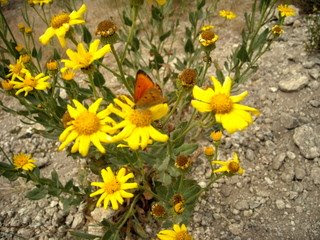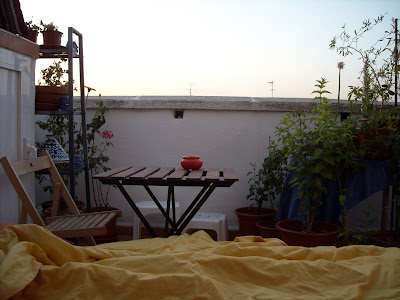The city of Madrid sits in the middle of Madrid province, and the north of the province climbs into the Guadarrama mountains. Habibi's in the UK right now, so I went off for a small solo adventure yesterday, returning to
Cercedilla to see what we missed in February.
From Cercedilla to Cotos takes about 40 minutes by train, and I'd been told that the walk back down takes about six hours, so I caught the first train out of Madrid, apiedrand was in Puerto de Cotos, booted & backpacked, by 11.30.

Only you can't walk down from there: the walk starts at
Navacerrada. In February we got off the little Cotos train too early. This time I'd stayed on too long. Which is how I came to spend the day walking more up than down, under the bluest sky, following paths through a landscape carved out aeons ago by glaciers, and now protected - and offered to José Public - as the
Parque Natural de Peñalara. I saw lots of butterflies and lizards, and heard crickets fizzing & buzzing in all directions, although it was mid-afternoon before I actually saw one. And two big birds of prey. I don't know what anything was, but I was out for hours and loved it. And I took some pictures.

 The blur in the picture above is a hummingbird moth, one of two I saw in the lavender planted outside the Casa de Cotos information centre.
The blur in the picture above is a hummingbird moth, one of two I saw in the lavender planted outside the Casa de Cotos information centre.

 Mirado del Gitano, Gypsy's View, with the arrow pointing at Cabeza de Hermano Mayor (Hermano Menor to the right) ............Big Brother & Little Brother.
Mirado del Gitano, Gypsy's View, with the arrow pointing at Cabeza de Hermano Mayor (Hermano Menor to the right) ............Big Brother & Little Brother.

 Laguna de los Pájaros in the distance from Ruta 2. It was actually a full-on, no-kidding, to-die-for cerulean blue, but everything I photograph comes out washed out, and has to be warmed up in Picasa before it even comes close to the original. So frustrating. Anyway, next Saturday, I shall be back in the mountains for another glacier-theme day out, walking along Ruta 4 to the Lake of the Birds, 2,175m. above sea level. The starting point, Casa de Cotos, is at something like 1,910, so it's not as much of a climb as it sounds!
Laguna de los Pájaros in the distance from Ruta 2. It was actually a full-on, no-kidding, to-die-for cerulean blue, but everything I photograph comes out washed out, and has to be warmed up in Picasa before it even comes close to the original. So frustrating. Anyway, next Saturday, I shall be back in the mountains for another glacier-theme day out, walking along Ruta 4 to the Lake of the Birds, 2,175m. above sea level. The starting point, Casa de Cotos, is at something like 1,910, so it's not as much of a climb as it sounds! 



 You have to try and imagine this lichen in 70s Retro lime green.
You have to try and imagine this lichen in 70s Retro lime green.

This was a warm day, some 26-30C but by early afternoon, the breeze had an edge to it. (The railway station cafe at Cercedilla had a snowy photograph of the Cotos train on the wall, and a collection of sleds and snowshoes.) It says something about the weather here that a building this size has buttresses...

This cairn is on the south side of the refuge (on the right of the picture), and an encouraging touch.

I don't think these scrapes are man-made.

Looking down from the refuge. This is a wetland area, with streams, peatbogs and frogs.

Laguna de Peñalara, 2,020m up. I thought that the blue, blue Laguna de los Pájaros was the Laguna de Peñalara - it's infinitely more impressive! This rather sad green pool has always been very popular with weekend escapees from Madrid, and has taken a battering over the years. Now it's being restored for wildlife. There's a ski slope a little way south east of the park, and in fact part of the park itself used to be a ski resort. It has been a conservation area since the late nineties, and they're working to restore the ecological balance of the area, without closing it to visitors.
On the other side, the cairns were the only markers for the descent.

Going down.

Looking back.

When I heard bells (and the sound carries a long way up there) I assumed that there were goats roaming. Madrid is so dry, it didn't occur to me that there could be wetlands so close, and I was surprised at the number of cows I saw from the train on the way to Cercedilla. I rather assumed that dairy farming was more or less exclusive to Galicia and Asturias, backing onto the Atlantic in the north.

The trees are healthy, but mostly naked on one side. Hmm, winter must be interesting up here.




The retama - a kind of broom or gorse - on the higher slopes still has a lot of sunny yellow flowers left, but lower down it has handsome fat pods covered in a purple-grey velvet - and usually a few surprise pinecones, dropped from the canopy of branches overhead.

It seems to me that most European wildflowers are yellow, blue or purple, which suggests that the so-called English cottage garden owes a great deal to the plant-hunters of previous centuries.











































